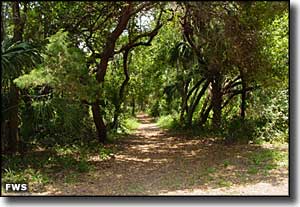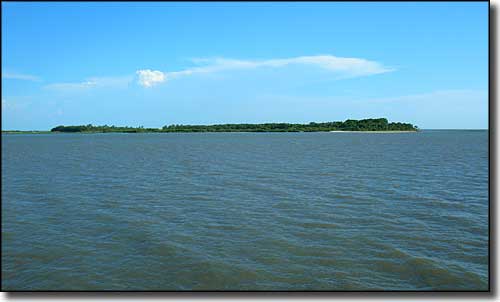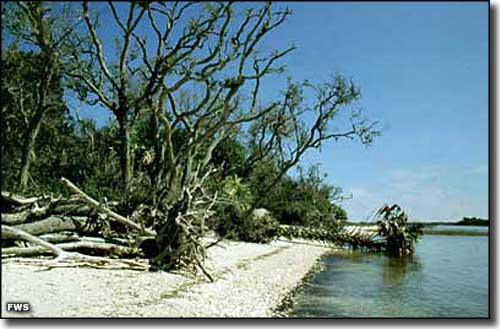Cedar Keys National Wildlife Refuge

An aerial view of North Key

Established in 1929, Cedar Keys National Wildlife Refuge today contains 762 acres spread across 13 islands off the coast of Cedar Key (at the southern terminus of State Road 24). At one time, many Native Americans used these islands for living purposes as food from the Gulf of Mexico was plentiful. More recently, Atsena Otie Key was home to the Faber Pencil Mill (built in 1868, now in ruins). Atsena Otie Key is managed by the National Wildlife Refuge but is actually owned by the Suwannee River Water Management District and that is where most public use of the refuge is concentrated. On Atsena Otie Key you'll find toilets, a pier into the Gulf, interpretive signage and a walking trail leading into the forest to a 19th century cemetery.
The historic lighthouse on Seahorse Key is leased by the University of Florida for use as a Marine Science Laboratory. They use the site for research purposes and also as a classroom for educating the public about the importance of this unique off-shore ecosystem.
Among the islands and marshes that make up Cedar Keys National Wildlife Refuge you'll find manatees, dolphins, shorebirds, wading birds, crabs, miscellaneous reptiles, bald eagles, brown pelicans, great and little blue herons, white ibis, great egrets, night herons, tri-colored herons, cormorants and all kinds of migratory birds in the various seasons.
The islands are all accessible by boat but they are surrounded by mud flats, so arriving at high tide and hanging out for a while may leave you (and your boat) stranded until the next high tide. The beaches are open to the public but the interiors of most islands are closed because of heavy, dense underbrush and poisonous snakes.

Between March 1 and June 30, all of Seahorse Key, including a 300-foot buffer zone around the island, is closed to public access to protect nesting birds. The beaches of Seahorse Key are open during the rest of the year but the interior is always closed. However, on the 3rd weekend of October from 9 am to 4 pm there is an open house at the Cedar Key Light Station on Seahorse Key.
The nearest camping spot to Cedar Keys National Wildlife Refuge is on Levy County Road 326, the road to the Shell Mound Unit (between Cedar Keys NWR and Lower Suwannee NWR). Camping is offered first come, first served and a small fee is charged. There are several other private (commercial) campgrounds nearby, too. You'll also find vendors in the town of Cedar Key who offer boat rentals and tour boat rides to the islands.
Cedar Keys National Wildlife Refuge is administered as part of the Lower Suwannee National Wildlife Refuge Complex. Snake, Seahorse, North and Deadman's Keys are also designated as Cedar Keys Wilderness Area.

One of the islands of the refuge from the pier at Cedar Key

Snake Key
Some photos courtesy of TheArmchairExplorer, CCA-by-SA 3.0 License
